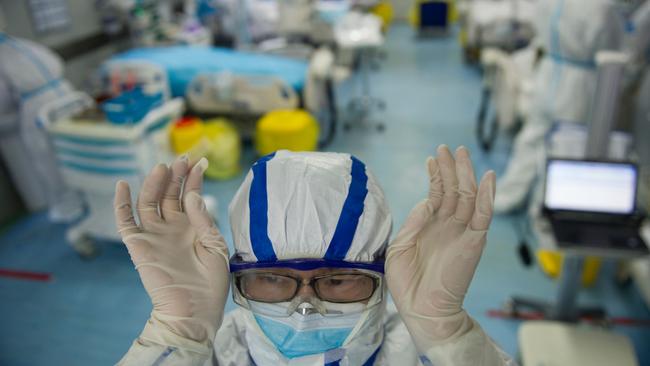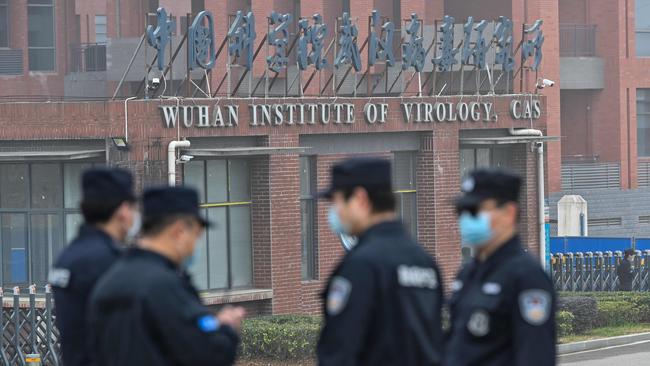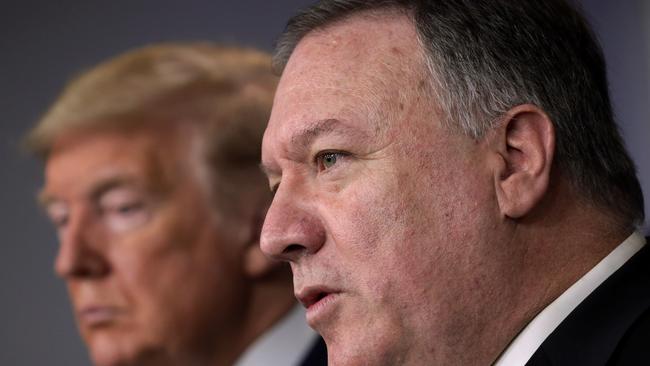What really happened in Wuhan: how China covered up the crisis
For Mike Pompeo, China’s refusal to accept help at the early stage rang immediate alarm bells. This is the inside story of how Beijing hid the truth from us all.

“Did you ever watch the movie The Sting?” former secretary of state Mike Pompeo boomed down the phone from Washington to me. “It’s an old movie. It’s a Robert Redford classic and he (and Paul Newman) run a scam and they have a section called the shut-out where they refuse to take this money from this guy in a bag. Anyway. We were getting the shut-out (from China).
“You could see it in the formal channels where there were formal requests for our medical team to provide support to the Chinese as they needed it and they said, ‘We’ve got this, no problem’. Then we’d ask for data and we’d be told, ‘We don’t have it, we’re working on it’.
“In the informal channels too (it was the same story). Then there was the public issues with the doctors, all the things they were shutting down. It was pretty clear by the end of January we were going to get the shut-out.”
It’s an insightful analogy. In the 1973 film, nominated for 10 Oscars and starring Paul Newman and Robert Redford, the con succeeds if the mob boss doesn’t realise he’s been cheated until the conmen are gone.

It’s not unlike China’s play on the US. America and – you could argue, although perhaps Pompeo wouldn’t – some in the Trump administration were thoroughly conned by China. By the time they realised the con, the pandemic had spread around the world.
For Pompeo, China’s refusal to accept help at this early stage rang immediate alarm bells and made him question whether the virus had come from the wet market at all. It was this lack of transparency as early as January that sparked the seed of doubt for Pompeo about a natural origin of Covid-19.
What was China hiding?
“The reason I start my answer to your question about when did we first suspect the Wuhan Institute of Virology as the potential place that could have got a leak, we started thinking about what the possibilities were as soon as we realised they were going to have none of us (in America) figuring this out,” Pompeo says.
“It puts you on alert. It says goodness gracious, you would think that the global response as required by the WHO, they’d want everyone in to come help them. But they wanted the antithesis of that.”
After spending a weekend at Mar-a-Lago, Donald Trump flew to Davos, Switzerland, for the World Economic Forum. On this trip, he spoke about the virus publicly for the first time when he sat down for a one-on-one interview with CNBC journalist Joe Kernen on January 22.
Kernen asked him at the start of the 20-minute sit-down about the case of coronavirus identified by the CDC (Centres for Disease Control and Prevention) in the US. “Are there any worries about a pandemic at this point?” Kernen wanted to know.
Trump replied: “No. Not at all. And we have it totally under control. It’s one person coming in from China, and we have it under control. It’s going to be just fine.”
Kernen followed up with a question about the transparency of Chinese President Xi Jinping, saying: “Do you trust that we’re going to know everything we need to know?”
Trump said he completely trusted the Chinese President to be transparent. “I do, I do, I have a great relationship with President Xi,” he said. “We’ve just signed probably the biggest deal ever made. I do, I think the relationship is very good.”
Alex Azar was pissed off at how the president downplayed the threat and praised China during the media interview. On Air Force One on the flight home from Davos, national security adviser Robert O’Brien took a call from the health secretary, who was in Washington. “Robert, this is serious, he can’t say it’s under control. That’s a term of art in public health and it isn’t accurate,” Azar said.
“The president can’t keep saying what he said on CNBC.”

When he got off the phone, O’Brien went to see the president during the flight. He told him they were monitoring the situation but were not getting any co-operation from the Chinese government. O’Brien says no one had a “good feel for it” at that point.
Back at the White House, on January 24, Azar briefed the president in the Oval Office on the escalating situation.
“How is China doing?” Trump asked.
“It seems pretty bad over there,” Azar replied.
“Are they being transparent?” the president wanted to know.
“Well, they’re being more transparent than they were with SARS, but that’s a very low bar, and with China you just don’t know what you don’t know,” Azar said. “I need to get the CDC in there on the ground to help them.”
Azar went on: “I’ve offered that. I need samples from China because we’ve got to do the infectious-disease tracing to figure out how this came about – what the origin is – and we need to get the original generation-one samples that they aren’t sharing.”
Trump said, “Well I’m going to tweet a statement that praises them for being transparent” as he called in his aid, Dan Scavino Jr, who wrote the first drafts of many of his official tweets.
Azar said, “Please don’t do that”, to no avail as Trump began to dictate to Scavino.
For some official tweets during the day, Trump would have Scavino write the tweet down and bring it back into the Oval Office printed and blown up in gigantic letters so the president could see any errors clearly. He’d make edits with a black sharpie and then say to Dan, “Let it rip”.
Azar implored Trump not to send the tweet. “If you give any praise to President Xi that’s a big win for him domestically,” the health minister said.
“He’s in trouble domestically because he’s clearly mismanaged this. There’s turmoil in China and if you pat him on the back and praise him, that’s validation, so please don’t do that.”
Azar felt Trump was quite set in what he wanted to do and continued on with Scavino. Frustrated, Azar walked out of the Oval Office in the middle of their meeting and strode across the lobby to O’Brien’s office.
“Robert, the president is about to send this tweet … We really can’t have him giving praise to China. We have got to stop him,” Azar said.
O’Brien went into the Oval Office and Pompeo was due to arrive in the West Wing shortly. Azar hoped the pair would be able to talk Trump down from praising China publicly, assuming that if Trump didn’t value advice on China from his health secretary, he might listen to his national security adviser and the secretary of state.
But Trump went on to send the tweet on January 24, assuring the public that China was co-operating with the US: “China has been working very hard to contain the coronavirus. The United States greatly appreciates their efforts and transparency. It will all work out well. In particular, on behalf of the American People, I want to thank President Xi!”

Dire warnings
The decision to play nice with Xi Jinping wouldn’t last long, and within a month the US–China relationship would deteriorate to new lows. Despite Trump dismissing the gravity of the virus publicly, sources close to the president say that he was acutely aware of the danger of the virus. He sat in the security briefings and heard the dire warnings. They were impossible to ignore.
But there was one thing Trump was even more concerned about than the spread of the virus through the US – and that was creating panic in the population, sparking an economic collapse.
“We worried about a panic, no question, 100 per cent. We were absolutely worried about a panic,” Trump’s then chief of staff Mick Mulvaney says.
“The president was very concerned about creating a panic, and the president believes in the power of positive thinking. And I think that came across in how he handled the Covid crisis. It was very difficult for him to go out there and give a worst-case scenario.
“When he goes out and says the disease will be gone by springtime, that was not entirely baseless. But it was certainly against the overwhelming evidence that was presented to him. Was there a chance that the disease would have gone away as the temperatures went up and the days got longer? Yes.
He would take little kernels, and magnify them in order to put the best face forward. In hindsight, obviously, it turns out to be something that hamstrung the administration’s response to the crisis.”
On March 1, Trump’s deputy chief of staff, Chris Liddell, threw a small dinner party at his home in Washington DC. It was a Sunday evening and still chilly in the nation’s capital. Gathered around the elegant dinner table were the upper echelons of the Trump administration: Mulvaney and his wife, Pamela West, and national economic council chair director Larry Kudlow and his wife, Judith.

To get the conversation rolling as they ate, Liddell posed a question to his guests, for each to answer around the table. “What is the big issue of 2020?” he asked. And one by one, the guests ticked off various topics. The soaring economy, Liddell himself nominated. The election that Trump was going to romp home, said Mulvaney. And so it went, around the table. Extraordinarily, not one of the six Americans nominated Covid-19 as the defining issue of 2020. None of them.
The four Australians present – one of them, a doctor – were astounded. They all said the coronavirus would be the defining issue of the year. Australian ambassador Joe Hockey suggested to the group that perhaps it would be a good idea to tell the American public to wear masks. “Maybe everyone should be wearing masks, because you remember SARS in Asia, that’s how they managed it. With masks,” he said to the men who had become his friends since he moved to Washington four years earlier. But he was shouted down, told that masks were “useless”. “You’d never get Americans to wear masks,” Mulvaney said.
Hockey, who remains close friends with Mulvaney and Liddell, couldn’t believe what he was hearing. They all thought it would pass, it was like a bad flu season. “None of them had ever managed a crisis because none of them had ever been in government before – at least not a crisis they didn’t manufacture themselves,” he said. “They were in denial, total denial. They thought it would be like Singapore, come the summer, it’ll pass. They were saying, ‘We’ve got it under control. It’s a mild flu.’ They had all the excuses. I don’t blame them. They were receiving confusing advice and they were following confusing leadership. They could see it potentially undermining Trump’s re-election strategy.”
Trump made the comparison with the flu himself days later on March 9. In a tweet he said, “So last year 37,000 Americans died from the common Flu. It averages between 27,000 and 70,000 per year. Nothing is shut down, life & the economy go on. At this moment there are 546 confirmed cases of coronavirus, with 22 deaths. Think about that!”
The next day he said, “And it hit the world. And we’re prepared, and we’re doing a great job with it. And it will go away. Just stay calm. It will go away.”
Puzzled, Hockey wondered whether the same intelligence that was warning Australia about the impending gravity of the situation was reaching the president and his most senior advisers. The Americans were so relaxed about the situation, Hockey questioned if maybe Australia was heading into lockdown unnecessarily. “At times I thought Australia was overreacting because I was in an environment where everyone was saying ‘Don’t overreact’,” he recalls.
“Washington is the centre of the universe and if something is happening on the other side of the world, it doesn’t seem real.”
Australia’s Defence Minister Peter Dutton, who at the time was minister for home affairs, says that in the US “there was a belief that this wasn’t going to hit their shores at that point in time. Australia had seen the intelligence. The predictions for us at that point were fairly dire. The initial advice to us was quite confronting, that we were going to run out of capacity within ICUs (intensive care units). Fortunately, that didn’t transpire.”
The White House’s dismissive approach to the coronavirus also alarmed Fox News’s top-rating host Tucker Carlson. He made his first-ever trip to Mar-a-Lago on March 7, 2020, to warn the president the situation could get really serious. He was particularly concerned the US may not have the medical capacity to deal with a pandemic.
Carlson had intended to keep his trip a secret, and even asked the Secret Service to help him sneak in undetected, but unbeknown to him, former Fox News host Kimberly Guilfoyle was holding her birthday party there. He was spotted instantly and news of his mission quickly leaked.
Carlson told Trump “this could be really bad” and expressed his view the United States had “missed the point where we can control it”.
“My concern was that we may not have the capacity to take all these patients and that we may not have the drugs to treat them,” Carlson said in an interview with Vanity Fair 10 days later. Carlson said he felt embarrassed about giving advice to the president of the United States, but trying to ensure the Trump administration took Covid-19 more seriously was what drove him to make the visit.
Strategic threat
It might have seemed as though President Xi was pulling the wool over Trump’s eyes, but this certainly wasn’t the case with Pompeo. He already intimately understood the serious strategic threat China posed from his time as CIA director.
And so it was that while Trump praised Xi Jinping for his transparency, Pompeo was alive to the reality of China’s cover-up of the virus. On a weekly, and sometimes daily, basis, he kept abreast of the conversations of Chinese whistleblowers and activists on WeChat. Many posts vanished just minutes after they were published. Pompeo understood there would be a cover-up only if there was something nefarious to keep quiet. It’s why he started to seriously examine the possibility that the virus did not have a natural origin.
“We began to look for alternative ways (it started) and everybody heard the wet market bat story, the pangolin story and you saw scientists saying this couldn’t have been man-made because we’ve looked at this thing, which was a bit of a straw man,” Pompeo tells me.
“Man-made belies the reality of what could have been done in a laboratory even if it was a natural source. In any event, you saw the Chinese begin to push that story (of the wet market and pangolins).
“Of course we knew the history of the lab because there had been Western connections to it. We knew a great deal about the laboratory. The French built it, designed it, we had provided scientists there that had partnered with them on research so we knew a good deal about what was taking place. And so it didn’t take us long after January before we had as a working hypothesis this possibility.”
While he was careful to never disagree with the president in public, it’s understood that Pompeo made his views known to Trump about China’s cover-up and responsibility for the global outbreak. The question remained: When was it time to tell the American public and the world about China’s activities at the Wuhan laboratories?
This is an edited extract of What Really Happened in Wuhan by Sharri Markson, published worldwide on September 29. Available by pre-order from Booktopia
What Really Happened in Wuhan, the documentary featuring Sharri Markson’s interview with Donald Trump, premieres on Sky News Australia on Monday September 20 at 8pm AEST.






To join the conversation, please log in. Don't have an account? Register
Join the conversation, you are commenting as Logout